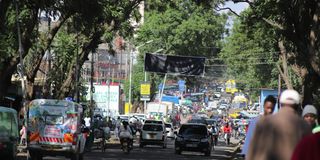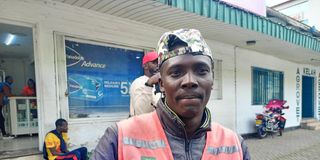Nakuru's gruelling traffic jam and the human error causing it

Traffic along Oginga Odinga road in the morning . The route is used by most motorists as an alternative route from the main highway; from Section 58 to get in and out of the city center.
Nakuru, once known for its manageable traffic and stress-free commutes, is now facing increasing urban congestion.
The city’s traffic situation has drastically deteriorated, particularly during peak hours, reflecting a trend similar to Nairobi’s long-standing traffic woes.
In an interview with boda boda rider Samuel Gachoka , he says the increase of private and commercial vehicles has turned previously short and predictable trips into long, stressful experiences.

Boda boda rider Samuel Gachoka during an interview with Mtaa Wangu on May 21,2025.
Gachoka says this shift is most evident on routes like the Whitehouse road and areas such as Section 58, where morning commutes can now take up to 40 minutes instead of the previous 10 minutes.
He says some people opt to use boda boda's especially in the morning just to get to work on time.
Mtaa Wangu observed that morning peak hours, especially from 7:15 am to 9:00 am are particularly gruelling. Even residents living close to town, like those in Upper Hill Estate, now find a five-minute journey stretching into half an hour or more.
The situation is mirrored in the evenings, with intense congestion and competition for public transport adding to commuter frustrations.
The lane going into town is especially affected, disrupting access to the city centre and forcing many commuters to alter their daily routines.
In response to congestion on the main highway, motorists have started using alternative routes like the lower Section 58 road, which connects to Oginga Odinga road.
Initially a convenient shortcut, this route is now overwhelmed due to increased use, particularly affecting motorists from areas like Naka.
Thus, congestion has merely shifted rather than reduced, turning quieter roads into new choke points.
The use of alternative routes such as Milimani Road, used by residents from neighbourhoods like Whitehouse, Bismark, Mawanga, and Sita , is at times a better option when the highway's traffic is unbearable.
Although sometimes effective in avoiding the worst jams, these routes are longer as one is forced to get to town through KFA. This increases fuel consumption.
In a Phone call interview, Nakuru County Traffic Enforcement Officer Allan Ogolla attributes the worsening congestion primarily to the increasing number of motorists in Nakuru.
“The problem is aggravated by traffic indiscipline, overlapping, improper lane usage, and boda boda riders flouting rules by riding against traffic to avoid longer routes, especially around Gati Iguru,” Mr Ogolla explains.
He says these behaviours contribute significantly to traffic build up and disruption of normal flow.
To address the crisis, Ogolla notes, they deploy at least six traffic enforcement officers across key congestion points including, Barnabas, Section 58, and the section between State House and the city centre.
Additionally, officers are also stationed at major roundabouts during peak hours to manage traffic flow.
Mr Ogolla put emphasis on the collaborative efforts with a multi-agency approach with authorities such as the Kenya National Highways Authority (KeNHA) to help in reducing snarl ups.
He however insists that without road discipline from drivers, even the best infrastructure and enforcement efforts will fall short.
"Only a shared commitment between authorities and road users can ensure Nakuru evolves into a city with a more efficient, reliable, and functional transport system," he concludes.


